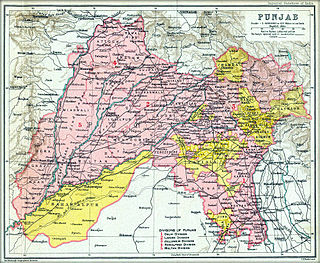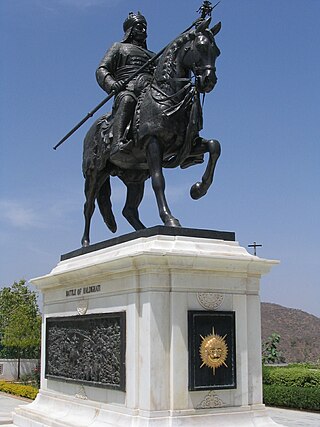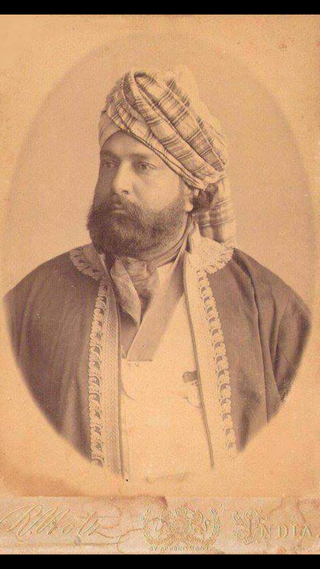
Bahawalpur is a city in the Punjab province of Pakistan. It is one of the ten largest cities of Pakistan and 6th most populous city of Punjab. Bahawalpur is the capital of Bahawalpur Division.

A princely state was a nominally sovereign entity of the British Indian Empire that was not directly governed by the British, but rather by an Indian ruler under a form of indirect rule, subject to a subsidiary alliance and the suzerainty or paramountcy of the British crown.
Aziz Mian Qawwal was a Pakistani traditional qawwal famous for singing ghazals in his own style of qawwali and is considered one of the greatest qawwals in South Asia. He holds the record for singing the longest commercially released qawwali, Hashr Ke Roz Yeh Poochhunga, which runs slightly over 150 minutes and. Aziz is known by sobriquets — "Shahenshah-e-Qawwali", "Fauji Qawwal"(Military Singer) since his early performances were often in army barracks, and "the Nietzschean qawwal".

Farīd al-Dīn Mas'ūd Ganj-i Shakar, commonly known as Bābā Farīd or Shaykh Farīd, was a 13th-century Punjabi Muslim preacher, poet and mystic, who remains one of the most revered and esteemed Muslim mystics of the Medieval India and the Islamic Golden age. He is revered by Punjabi Muslims, Hindus and Sikhs alike.

Amb or the State of Amb was a princely state in the present day Khyber Pakhtunkhwa region of Pakistan. Together with Phulra, it was known as Feudal Tanawal ruled by Tanoli tribe. A Royal Tenure start from Timurid Empire and end on Last Nawab Muhammad Farid Khan Tanoli. Amb was only powerful state incorporated in Pakistan with armed civilized military of 12,000 men, 300 Howitzer with their own manufacturing arms factory, today part of the Pakistan Army. Amb had a influence control roots in Swat, Dir and Chitral. A gaining of powerful roots of Amb military start from Second Anglo-Sikh War when East India Company provide military equipment to Jehandad Khan Tanoli to fight against Sikh, and then next British Empire in Second anglo-Afghan War. At the end of December 1947, the Nawab of Amb state acceded to Pakistan while retaining internal self-government. Amb continued as a princely state of Pakistan until 1969, when it was incorporated into the North West Frontier Province.

Dir was a princely state in a subsidiary alliance with the British Raj, located within the North-West Frontier Province. Following the Partition of British India, Dir remained independent and unaligned until February 1948, when the Dominion of Pakistan accepted its accession.

The Punjab States Agency was an agency of the British Raj. The agency was created in 1921, on the model of the Central India Agency and Rajputana Agency, and dealt with forty princely states in northwest India formerly dealt with by the Province of Punjab.

Rana is a historical title denoting an absolute Hindu monarch in the Indian subcontinent. Today, it is used as a hereditary name in the Indian subcontinent. "Rana" was formerly used as a title of martial sovereignty by Rajput kings in India. Rani is the title for the wife of a rana or a female monarch. It also applies to the wife of a raja. Compound titles include rana sahib, ranaji, raj rana,rana bahadur, and maharana.

Khan Bahadur Raja Jahandad Khan, (1849–1906) was a politician and Chief of the Gakhars and a descendant of Sultan Sarang Khan Ghakkar, King of Potohar.
Muhammad Amjad, was a legal scholar of Qur'an, Hadith, and the Hanafi school of Islamic law.
Khan Sahib, Qazi Zafar Hussain came from a qadi's family which had, since the 16th century, been prominent among the landed aristocracy of the Soon Valley. He belonged to Awans tribe of ancient repute. He was awarded the title of Khan Sahib by the British Crown. This was a formal title, a compound of khan (leader) and sahib (Lord), which was conferred in Mughal Empire and British India. Although his father, Qazi Mian Muhammad Amjad forbade his descendants to establish Dargah, he was considered Sajjada Nashin by the people of his area. "Sajjada nashins" David Gilmartin asserts, "claimed to be the descendants of the Sufi, 'saints', intermediaries between the Faithful and their God, and this cut against the grain of Islamic orthodoxy ... in kind, of their special religious status, these sajjada nashins had become men of local standing in their own right." However he never claimed to be a Sajjada Nashin. In the Punjab, the sajjada nashin or pir families were not so rich in terms of land as the great land lords of Punjab but these sajjada nashin or pir families exerted great political and religious influence over the people. The British could not administer the area without their help and no political party could win the election without their help.
Dharampura is a residential neighbourhood located in Lahore. The Mughal emperor Akbar laid the foundation of this colony for Hindus as an alms-house in 1583. After 1947 Partition, it was renamed Mustafabad but is still locally known as Dharampura.

The Shrine of Mian Mir is a 17th-century shrine located in Lahore, Pakistan, that is dedicated to the Sufi mystic Mian Mir. The shrine is one of the most celebrated in Lahore, and has historically been revered by both Muslims and Sikhs.
Mian is a surname, and can also be used as a given name.

Mian Sahib , Mian Jo Goth(Sindhi: ميان جو گوٺ) is the town of Shikarpur District in the Sindh Province of Pakistan, is a union council. It is located at 28°9'17"N 68°38'32"E at an altitude of 59 metres. Mian Sahib, is a historical village of Shikarpur District, although Mian Sahib is now a relatively small city, it borders with the nearest town Mubarakpur, Jacobabad town of Jacobabad District and it's also the largest town of the tehsil Khanpur, Sindh Of Shikarpur District.
Khwaja Fazal Mohammed [Sufi name : Gawahi Shah] was a Sufi Pīr and philosopher of the Ni'matullāhī order. He served as the Samanta of Madhi from 1834 to 1868. Khwaja Fazal Mohammed played an instrumental role in bringing the teachings of Ni'matullāhī order to Odisha. His tomb at Solada, Dhenkanal is the only tomb of a Ni'mātullāhī wali in Odisha and is revered by both Hindus and Muslims.
The Muslim Gujjars or Musalmān Gujjars are the descendants of Gujjars in the northern regions of the Indian subcontinent who are followers of Islam. They converted from Hinduism to Islam from the medieval period onwards. Today, Muslim Gujjars can be found mostly in present-day Northern India and Pakistan. They are further divided into different clans.










